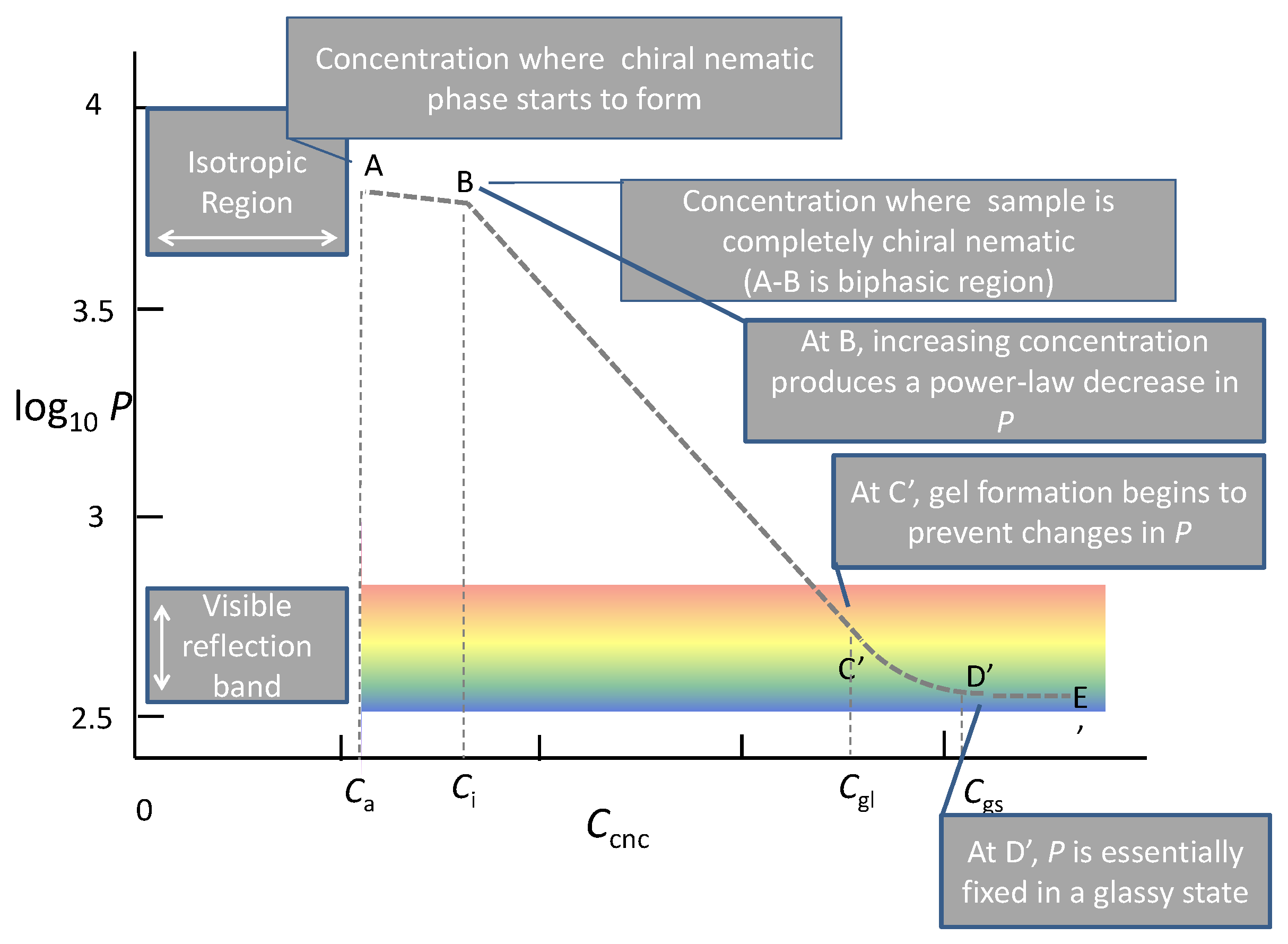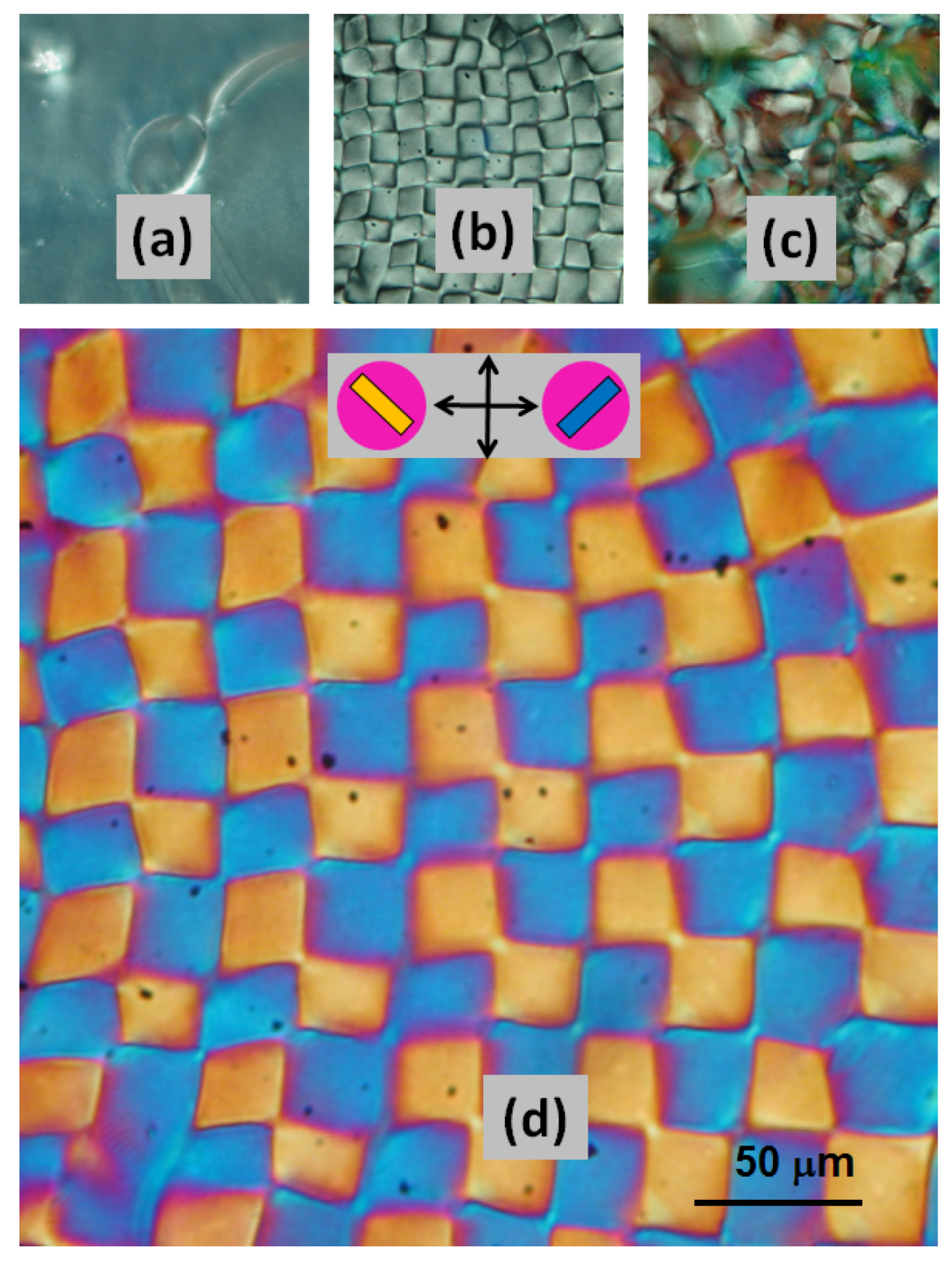Recent Advances in Chiral Nematic Structure and Iridescent Color of Cellulose Nanocrystal Films
Abstract
:1. Introduction
2. Overview of Drying Process
- A dilute isotropic suspension in which individual CNC, normally stabilized by anionic sulfate half ester or carboxyl groups on their surfaces, are in Brownian motion, giving a clear slightly viscous fluid when the suspension is stable.
- As the concentration of CNC is increased, an ordered chiral nematic phase starts to form. The ordered phase often initially appears as “tactoids”, droplets of anisotropic phase surrounded by the isotropic phase. Note that in this biphasic region, the concentration of CNC in the continuous isotropic phase is only slightly lower than in the anisotropic phase [6], and that the tactoids readily aggregate to form a continuous anisotropic phase. In principal, P remains constant across the biphasic region.
- As the concentration is increased beyond the two-phase region, the suspension becomes a cloudy viscous fluid that appears almost completely anisotropic by polarized light microscopy. The pitch, P, decreases monotonically as the concentration of CNC increases.
- Depending on the dimensions and charge of the CNC, a concentration is reached where the suspension starts to form a gel, inhibiting the further decrease in P.
- Eventually, the gel may lose more water, trapping the chiral nematic organization in the glassy state.
3. Kinetic Factors that Control P during Evaporation
4. Carboxyl-Stabilized CNC Suspensions and Films
5. Liquid Crystalline Textures Observed by Polarized Light Microscopy
6. Polarized Light Microscopy of Solid CNC Films
7. Topography of Solid CNC Film Surfaces
8. Shear Effects on Texture and Surface Topography
9. Conclusions
Acknowledgments
Conflicts of Interest
References
- Dufresne, A. Nanocellulose; Walter de Gruyter: Berlin, Germany, 2012. [Google Scholar]
- Moon, R.J.; Schueneman, G.T.; Simonsen, J. Overview of Cellulose Nanomaterials, Their Capabilities and Applications. JOM 2016, 68, 2383–2394. [Google Scholar] [CrossRef] [PubMed]
- Revol, J.-F.; Giasson, J.; Marchessault, R.H.; Gray, D.G. Helicoidal Self-ordering of Cellulose Microfibrils in Aqueous Suspension. Int. J. Biol. Macromol. 1992, 14, 170–172. [Google Scholar] [CrossRef]
- Revol, J.-F.; Godbout, L.; Gray, D.G. Solidified Liquid Crystals of Cellulose with Optically Variable Properties. U.S. Patent 5,629,055, 13 May 1997. [Google Scholar]
- De Vries, H. Rotatory Power and other Optical Properties of Certain Liquid Crystals. Acta Crystallogr. 1951, 4, 219–226. [Google Scholar] [CrossRef]
- Dong, X.M.; Kimura, T.; Revol, J.-F.; Gray, D.G. Effects of Ionic Strength on the Phase Separation of Suspensions of Cellulose Crystallites. Langmuir 1996, 12, 2076–2082. [Google Scholar] [CrossRef]
- Beck, S.; Bouchard, J.; Berry, R. Controlling the Reflection Wavelength of Iridescent Solid Films of Nanocrystalline Cellulose. Biomacromolecules 2011, 12, 167–172. [Google Scholar] [CrossRef] [PubMed]
- Charlet, G.; Gray, D.G. Solid Cholesteric Films Cast from Aqueous (Hydroxypropyl)cellulose. Macromolecules 1987, 20, 33–37. [Google Scholar] [CrossRef]
- Dong, X.M.; Gray, D.G. Induced Circular Dichroism of Isotropic and Magnetically-Oriented Chiral Nematic Suspensions of Cellulose Crystallites. Langmuir 1997, 13, 2076–2082. [Google Scholar] [CrossRef]
- Mu, X.; Gray, D.G. Formation of chiral nematic films from cellulose nanocrystal suspensions is a two-stage process. Langmuir 2014, 30, 9256–9260. [Google Scholar] [CrossRef] [PubMed]
- Beck, S.; Bouchard, J.; Chauve, G.; Berry, R. Controlled production of patterns in iridescent solid films of cellulose nanocrystals. Cellulose 2013, 20, 1401–1411. [Google Scholar] [CrossRef]
- Lagerwall, J.P.F.; Schütz, C.; Salajkova, M.; Noh, J.H.; Park, J.H.; Scalia, G.; Bergström, L. Cellulose nanocrystal-based materials: From liquid crystal self-assembly and glass formation to multifunctional thin films. NPG Asia Mater. 2014, 6, e80. [Google Scholar] [CrossRef]
- Ureña-Benavides, E.E.; Ao, G.; Davis, V.A.; Kitchens, C.L. Rheology and Phase Behavior of Lyotropic Cellulose Nanocrystal Suspensions. Macromolecules 2011, 44, 8990–8998. [Google Scholar] [CrossRef]
- Dumanli, A.G.; Kamita, G.; Landman, J.; van der Kooij, H.; Glover, B.J.; Baumberg, J.J.; Steiner, U.; Vignolini, S. Controlled, Bioinspired Self-Assembly of Cellulose-Based Chiral Reflectors. Adv. Opt. Mater. 2014, 2, 646–650. [Google Scholar] [CrossRef] [PubMed]
- Honorato-Rios, C.; Kuhnhold, A.; Bruckner, J.; Dannert, R.; Schilling, T.; Lagerwall, J.P.F. Equilibrium Liquid Crystal Phase Diagrams and Detection of Kinetic Arrest in Cellulose Nanocrystal Suspensions. Front. Mater. 2016, 3, 75. [Google Scholar] [CrossRef]
- Dorris, A.; Gray, D.G. Gelation of cellulose nanocrystal suspensions in glycerol. Cellulose 2012, 19, 687–694. [Google Scholar] [CrossRef]
- Bruckner, J.R.; Kuhnhold, A.; Honorato-Rios, C.; Schilling, T.; Lagerwall, J.P.F. Enhancing Self-Assembly in Cellulose Nanocrystal Suspensions Using High-Permittivity Solvents. Langmuir 2016, 32, 9854–9862. [Google Scholar] [CrossRef] [PubMed]
- Araki, J.; Wada, M.; Kuga, S. Steric Stabilization of a Cellulose Microcrystal Suspension by Poly(ethylene glycol) Grafting. Langmuir 2001, 17, 21–27. [Google Scholar] [CrossRef]
- Leung, A.C.W.; Hrapovic, S.; Lam, E.; Liu, Y.; Male, K.; Mahmoud, K.A.; Luong, J.H.T. Characteristics and properties of carboxylated cellulose nanocrystals prepared from a novel one-step procedure. Small 2011, 7, 302–305. [Google Scholar] [CrossRef] [PubMed]
- Lam, E.; Leung, A.C.W.; Liu, Y.; Majid, E.; Hrapovic, S.; Male, S.K.B.; Luong, J.H.T. Green strategy guided by raman spectroscopy for the synthesis of ammonium carboxylated nanocrystalline cellulose and the recovery of byproducts. ACS Sustain. Chem. Eng. 2013, 1, 278–283. [Google Scholar] [CrossRef]
- Castro-Guerrero, C.F.; Gray, D.G. Preparation and properties of cellulose nanocrystals prepared by oxidation with ammonium persulfate. Cellulose 2014, 21, 2567–2577. [Google Scholar] [CrossRef]
- Collings, P.J.; Hird, M. Introduction to Liquid Crystals: Chemistry and Physics; Taylor and Francis: London, UK, 1997. [Google Scholar]
- Chen, W.; Gray, D.G. Interfacial Tension between Isotropic and Anisotropic Phases of a Suspension of Rod-like Particles. Langmuir 2002, 18, 633–637. [Google Scholar] [CrossRef]
- Revol, J.F.; Godbout, L.; Dong, X.M.; Gray, D.G.; Chanzy, H.; Maret, G. Chiral nematic suspensions of cellulose crystallites; phase separation and magnetic field orientation. Liq. Cryst. 1994, 16, 127–134. [Google Scholar] [CrossRef]
- Tatsumi, M.; Kimura, F.; Kimura, T.; Teramoto, Y.; Nishio, Y. Anisotropic Polymer Composites Synthesized by Immobilizing Cellulose Nanocrystal Suspensions Specifically Oriented under Magnetic Fields. Biomacromolecules 2014, 15, 4579–4589. [Google Scholar] [CrossRef] [PubMed]
- De France, K.J.; Yager, K.G.; Hoare, T.; Cranston, E.J. Cooperative Ordering and Kinetics of Cellulose Nanocrystal Alignment in a Magnetic Field. Langmuir 2016, 32, 7564–7571. [Google Scholar] [CrossRef] [PubMed]
- Dumanli, A.G.; van der Kooij, H.M.; Kamita, G.; Reisner, E.; Baumberg, J.J.; Steiner, U.; Vignolini, S. Digital color in cellulose nanocrystal films. ACS Appl. Mater. Interfaces 2014, 6, 12302–12306. [Google Scholar] [CrossRef] [PubMed]
- Roman, M.; Gray, D.G. Parabolic Focal Conics in Self-Assembled Solid Films of Cellulose Nanocrystals. Langmuir 2005, 21, 5555–5561. [Google Scholar] [CrossRef] [PubMed]
- Mu, X.; Gray, D.G. Droplets of cellulose nanocrystal suspensions on drying give iridescent 3-D “coffee-stain” rings. Cellulose 2015, 22, 1103–1107. [Google Scholar] [CrossRef]
- Gray, D.G.; Mu, X. Chiral Nematic Structure of Cellulose Nanocrystal Suspensions and Films; Polarized Light and Atomic Force Microscopy. Materials 2015, 8, 7873–7888. [Google Scholar] [CrossRef]
- Rofouie, P.; Pasini, D.; Rey, A.D. Nano-scale surface wrinkling in chiral liquid crystals and plant-based plywoods. Soft Matter 2015, 11, 1127–1159. [Google Scholar] [CrossRef] [PubMed]
- Tatsumi, M.; Teramoto, Y.; Nishio, Y. Different orientation patterns of cellulose nanocrystal films prepared from aqueous suspensions by shearing under evaporation. Cellulose 2015, 22, 2983–2992. [Google Scholar] [CrossRef]
- Fernandes, S.N.; Geng, Y.; Vignolini, S.; Glover, B.J.; Trindade, A.C.; Canejo, J.P.; Almeida, P.L.; Brogueira, P.; Godinho, M.H. Structural Color and Iridescence in Transparent Sheared Cellulosic Films. Macromol. Chem. Phys. 2013, 214, 25–32. [Google Scholar] [CrossRef]
- Ličen, M.; Majaron, B.; Noh, J.; Schütz, C.; Bergström, L.; Lagerwall, J.; Drevenšek-Olenik, I. Correlation between structural properties and iridescent colors of cellulose nanocrystalline films. Cellulose 2016. [Google Scholar]
- Gray, D.G.; Mu, X. Twist-Bend Stage in the Relaxation of Sheared Chiral Nematic Suspensions of Cellulose Nanocrystals. ACS Omega 2016, 1, 212–219. [Google Scholar] [CrossRef]



© 2016 by the author; licensee MDPI, Basel, Switzerland. This article is an open access article distributed under the terms and conditions of the Creative Commons Attribution (CC-BY) license (http://creativecommons.org/licenses/by/4.0/).
Share and Cite
Gray, D.G. Recent Advances in Chiral Nematic Structure and Iridescent Color of Cellulose Nanocrystal Films. Nanomaterials 2016, 6, 213. https://doi.org/10.3390/nano6110213
Gray DG. Recent Advances in Chiral Nematic Structure and Iridescent Color of Cellulose Nanocrystal Films. Nanomaterials. 2016; 6(11):213. https://doi.org/10.3390/nano6110213
Chicago/Turabian StyleGray, Derek G. 2016. "Recent Advances in Chiral Nematic Structure and Iridescent Color of Cellulose Nanocrystal Films" Nanomaterials 6, no. 11: 213. https://doi.org/10.3390/nano6110213
APA StyleGray, D. G. (2016). Recent Advances in Chiral Nematic Structure and Iridescent Color of Cellulose Nanocrystal Films. Nanomaterials, 6(11), 213. https://doi.org/10.3390/nano6110213





